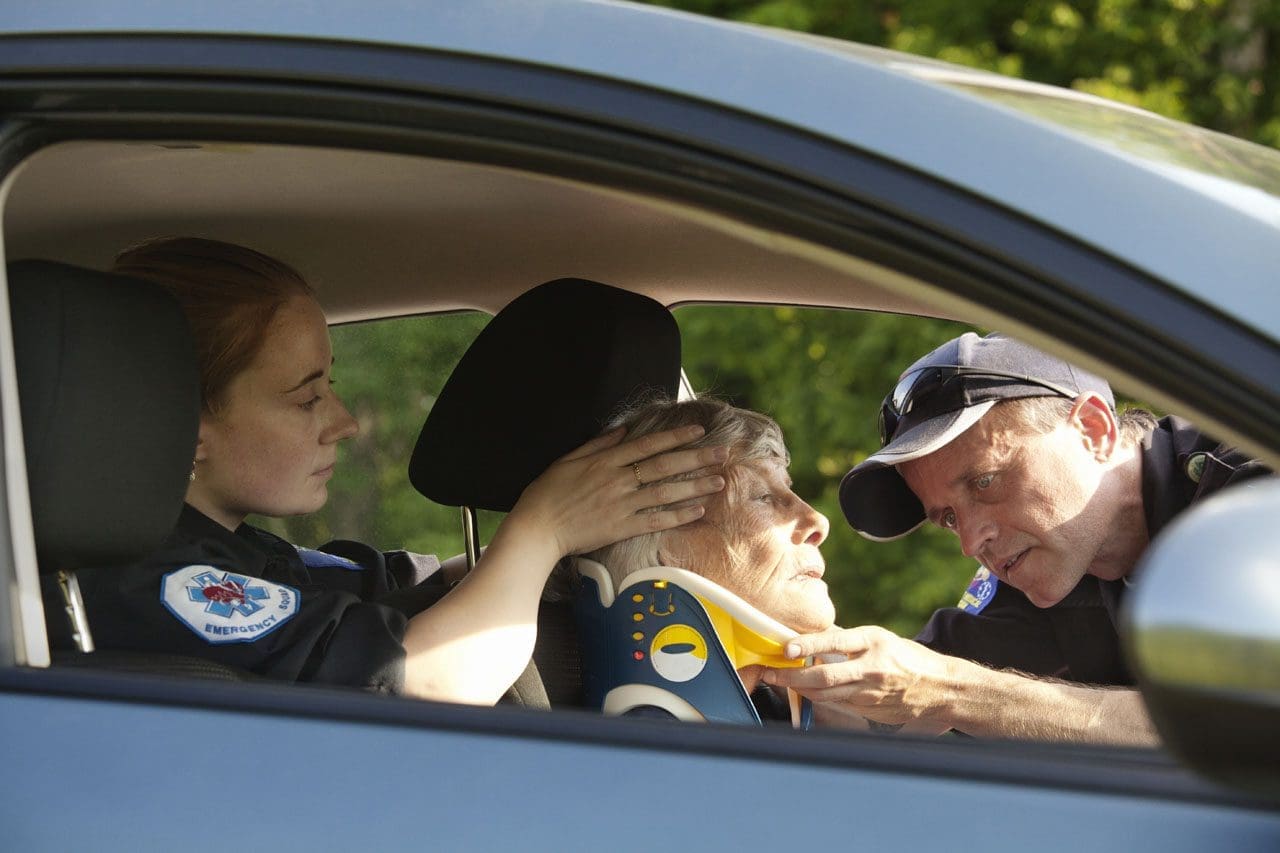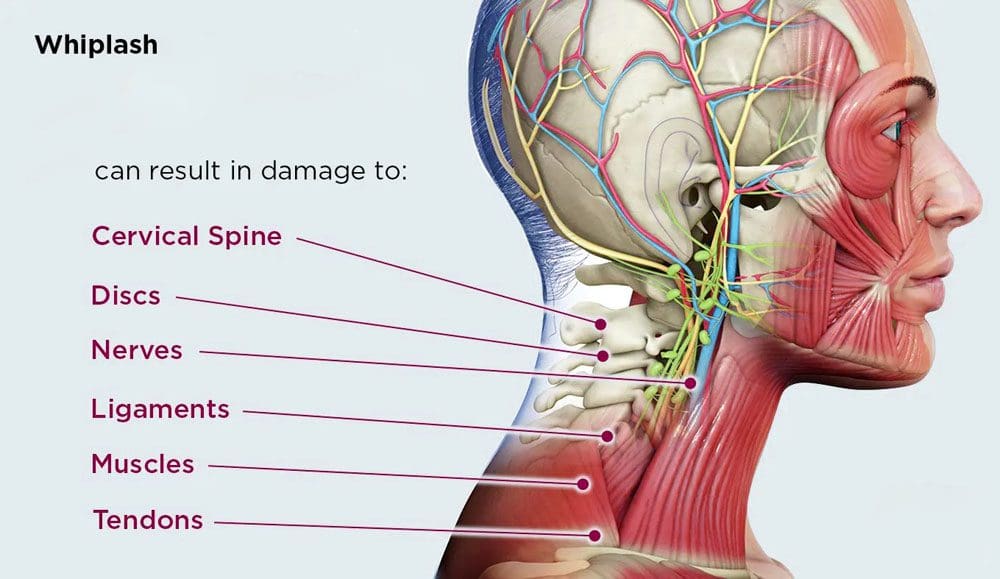
Whiplash-associated disorders, or WAD, describe injuries sustained from sudden acceleration/deceleration movements. It is a common outcome after a motor vehicle collision but can also be caused by sports injuries, falls, or assaults. Whiplash refers to the mechanism of the injury, while WAD refers to the presence of symptoms like pain, stiffness, muscle spasm, and headaches. A WAD prognosis is unpredictable, with some cases remaining acute with a full recovery, while others progress to chronic conditions with long-term symptoms and disability. Early intervention recommendations include rest, chiropractic care and physical rehabilitation, massaging and stretching exercises, and an anti-inflammatory diet.
Table of Contents
Whiplash Associated Disorders
Cervical hyperextension injuries happen to drivers and passengers of moving, slow-moving (less than 14 miles per hour), and stationary vehicles when struck from behind.
- The individual’s body is thrown forward, but the head does not follow the body and instead whips forward, resulting in hyperflexion or extreme forward movement of the neck.
- The chin limits forward flexion, but the momentum can be sufficient to cause cervical distraction and neurological injuries.
- When the head and neck have reached maximum flexion, the neck snaps back, resulting in hyperextension or extreme backward movement of the neck.
Pathology
Most WADs are considered soft tissue-based injuries with no fractures.
Stages
The injury goes through stages:
Stage 1
- The upper and lower spine experiences flexion in stage one.
Stage 2
- The spine takes on an S-shape while extending and eventually straightens, causing lordosis.
Stage 3
- The entire spine is hyperextending with an intense force that causes the facet joint capsules to compress.
Symptoms
Whiplash-associated disorders can be classified through grades by the severity of symptoms, including neck pain, stiffness, occipital headache, cervical, thoracic, and lumbar back pain, upper-limb pain, and paraesthesia.
Grade 0
- No complaints or physical symptoms.
Grade 1
- Neck complaints but no physical symptoms.
Grade 2
- Neck complaints and musculoskeletal symptoms.
Grade 3
- Neck complaints and neurological symptoms.
Grade 4
- Neck complaints and fracture and/or dislocation.
- Most cervical fractures occur predominantly at C2 or C6, or C7.
- Most fatal cervical spine injuries occur at the craniocervical junction C1 or C2.
Affected Spinal Structures
Some symptoms are thought to be caused by injury to the following structures:
- Cervical Spine
- Nerve roots
- Spinal ligaments
- Facet Joint Capsule
- Facet joints
- Intervertebral discs
- Cartilage
- Paraspinal muscles causing spasms
Causes of pain can be from any of these tissues, with the strain of the injury causing secondary edema, hemorrhage, and inflammation.
Joints
- Zygapophyseal joints
- Atlanto-axial joint
- Atlanto-occipital joint
- Intervertebral discs
- Cartilaginous endplates
Adjacent Joints
- Temporomandibular joint
- Shoulder complex
- Thoracic spine
- Ribs
Spinal Muscles
Ligaments
- Alar ligament
- Anterior atlanto-axial ligament
- Anterior atlanto-occipital ligament
- Apical ligament
- Anterior longitudinal ligament
- Transverse ligament of the atlas
Bones
- Atlas
- Axis
- Vertebrae C3-C7
Nervous Systems Structures
- Nerve roots
- Spinal cord
- Brain
- Sympathetic nervous system
Vascular System Structures
- Internal carotid artery
- Vertebral artery
Peripheral Vestibular System
Chiropractic Care
A chiropractor will identify areas of restricted joint motion, muscle tension, muscle spasm, intervertebral disc injury, and ligament injury.
- They will analyze posture, and spinal alignment, check for tenderness, tightness, and how well the spinal joints move.
- This will allow the chiropractic physical therapy team to understand the injured body mechanics and how the spine is operating to make a thorough diagnosis.
- The doctor will order imaging tests like an x-ray or an MRI to evaluate any degenerative changes that may have existed before the whiplash injury.
- Once the injury has been accurately diagnosed, the chiropractor will design a personalized treatment plan.
Spinal Adjustments
- Spinal manipulation is applied to areas of the spine that are out of alignment to realign the spine and activate the healing process.
- Flexion-distraction technique is a gentle technique that uses slower, less intense pushing motions on the discs used to treat disc herniations that often occur after a whiplash injury.
- Instrument-assisted manipulation utilizes special instruments to apply various forces or massage settings to the area.
- Targeted spinal manipulation targets specific areas to rework, release, and rebuild the structures.
- Massage Therapy stimulates the affected muscles to relax them from their tense state.
- A treatment plan may utilize:
- Instrument-assisted therapy
- Trigger point therapy
- Resistance-based stretches to rehabilitate soft tissue damage.
Our chiropractic team is ready to help you feel your best so you can return to normal activities and get on with your life.
Automobile Injuries and Chiropractic
References
Pastakia, Khushnum, and Saravana Kumar. “Acute whiplash associated disorders (WAD).” Open access emergency medicine: OAEM vol. 3 29-32. 27 Apr. 2011, doi:10.2147/OAEM.S17853
Ritchie, C., Ehrlich, C. & Sterling, M. Living with ongoing whiplash-associated disorders: a qualitative study of individual perceptions and experiences. BMC Musculoskelet Disord 18, 531 (2017). doi.org/10.1186/s12891-017-1882-9
www.sciencedirect.com/topics/medicine-and-dentistry/whiplash-associated-disorder
Sterling, Michele. “Whiplash-associated disorder: musculoskeletal pain and related clinical findings.” The Journal of manual & manipulative therapy vol. 19,4 (2011): 194-200. doi:10.1179/106698111X13129729551949
Wong, Jessica J et al. “Are manual therapies, passive physical modalities, or acupuncture effective for the management of patients with whiplash-associated disorders or neck pain and associated disorders? An update of the Bone and Joint Decade Task Force on Neck Pain and Its Associated Disorders by the OPTIMa collaboration.” The spine journal: official Journal of the North American Spine Society vol. 16,12 (2016): 1598-1630. doi:10.1016/j.spinee.2015.08.024
Woodward, M N et al. “Chiropractic treatment of chronic ‘whiplash’ injuries.” Injury vol. 27,9 (1996): 643-5. doi:10.1016/s0020-1383(96)00096-4
Disclaimers
Professional Scope of Practice *
The information herein on "WAD Whiplash Associated Disorders: Health Coach Clinic" is not intended to replace a one-on-one relationship with a qualified health care professional or licensed physician and is not medical advice. We encourage you to make healthcare decisions based on your research and partnership with a qualified healthcare professional.
Blog Information & Scope Discussions
Welcome to El Paso's wellness blog, where Dr. Alex Jimenez, DC, FNP-C, a board-certified Family Practice Nurse Practitioner (FNP-C) and Chiropractor (DC), presents insights on how our team is dedicated to holistic healing and personalized care. Our practice aligns with evidence-based treatment protocols inspired by integrative medicine principles, similar to those found on dralexjimenez.com, focusing on restoring health naturally for patients of all ages.
Our areas of chiropractic practice include Wellness & Nutrition, Chronic Pain, Personal Injury, Auto Accident Care, Work Injuries, Back Injury, Low Back Pain, Neck Pain, Migraine Headaches, Sports Injuries, Severe Sciatica, Scoliosis, Complex Herniated Discs, Fibromyalgia, Chronic Pain, Complex Injuries, Stress Management, Functional Medicine Treatments, and in-scope care protocols.
Our information scope is limited to chiropractic, musculoskeletal, physical medicine, wellness, contributing etiological viscerosomatic disturbances within clinical presentations, associated somato-visceral reflex clinical dynamics, subluxation complexes, sensitive health issues, and functional medicine articles, topics, and discussions.
We provide and present clinical collaboration with specialists from various disciplines. Each specialist is governed by their professional scope of practice and their jurisdiction of licensure. We use functional health & wellness protocols to treat and support care for the injuries or disorders of the musculoskeletal system.
Our videos, posts, topics, subjects, and insights cover clinical matters, issues, and topics that relate to and directly or indirectly support our clinical scope of practice.*
Our office has reasonably attempted to provide supportive citations and has identified the relevant research studies or studies supporting our posts. We provide copies of supporting research studies available to regulatory boards and the public upon request.
We understand that we cover matters that require an additional explanation of how they may assist in a particular care plan or treatment protocol; therefore, to discuss the subject matter above further, please feel free to ask Dr. Alex Jimenez, DC, APRN, FNP-BC, or contact us at 915-850-0900.
We are here to help you and your family.
Blessings
Dr. Alex Jimenez DC, MSACP, APRN, FNP-BC*, CCST, IFMCP, CFMP, ATN
email: coach@elpasofunctionalmedicine.com
Licensed as a Doctor of Chiropractic (DC) in Texas & New Mexico*
Texas DC License # TX5807
New Mexico DC License # NM-DC2182
Licensed as a Registered Nurse (RN*) in Texas & Multistate
Texas RN License # 1191402
ANCC FNP-BC: Board Certified Nurse Practitioner*
Compact Status: Multi-State License: Authorized to Practice in 40 States*
Graduate with Honors: ICHS: MSN-FNP (Family Nurse Practitioner Program)
Degree Granted. Master's in Family Practice MSN Diploma (Cum Laude)
Dr. Alex Jimenez, DC, APRN, FNP-BC*, CFMP, IFMCP, ATN, CCST
My Digital Business Card
